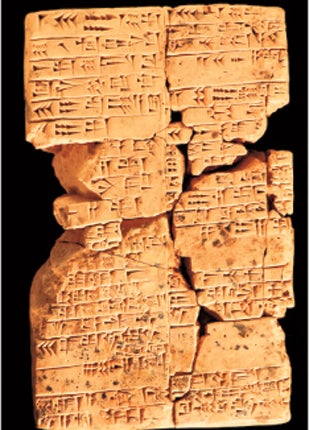Relics kept in the Twin Towers sent back to Iraq

In all the twists and tragedies spanning 9/11 and the invasion of Iraq, few would think to look for a happy subplot in the world of archaeology. But consider the travails of 362 tiny clay tablets. Forged in southern Iraq 4,000-odd years ago, then crushed in the collapse of the twin towers, the tablets are now back in Iraq.
Decorated with cuneiform script – the oldest-known form of human writing – the tiny tablets were shipped in early 2001 from Dubai to the Port of Newark in New Jersey by smugglers. There were presumably headed to new hands in return for considerable sums of money. The tablets, each one smaller than a deck of cards, were initially valued at $330,000. In another sense, though, they were priceless, in part because they referenced one of the most powerful officials of the Third Dynasty of Ur, 2000 years before Christ.
Thank goodness for US Customs, who got wind of the delicate merchandise and confiscated it upon landing. But then something less positive happened: they put them in storage at the very bottom of one of the twin towers.
"I was aghast. I was horrified," James McAndrew, a senior special agent with US Customs, said of the moment that he realised that along with all the human loss at ground zero, the Iraqi tablets were surely gone too. "We had stored the tablets down there, and then when 9/11 happened, the building was destroyed along with everything else," he told The New York Times, this week, which reported the story of the tablets' modern odyssey and return to Iraq.
The first miracle occurred when rescue teams finally reached the basement of the "pile" at ground zero and had time to begin retrieving stored items. The boxes of tablets were still there, but there was a problem: they had partly crumbled because of the collapse of the towers but also because they had been soaked with water.
Even as the tablets were formally returned to the Iraqi government at a quiet ceremony in Washington in 2008, the US State Department stepped forward with $100,000 to pay for experts in ancient artefacts in America to reassemble them more or less to the state they were in when they first showed up in Newark. That done, they were packed again and sent on the return leg of a journey that never should have been. On 7 September – almost exactly nine years after 9/11 – the tablets were received home by the Iraq National Museum in Baghdad.
"They've certainly been on a crazy journey," John Russell told the Times. An art history professor at the Massachusetts College of Art and Design, who was involved in the restoration of the tablets, Mr Russell added: "Iraq is rising from a period of considerable difficulty, and I think the restoration of these tablets and restoring them to their owners in a stable condition is kind of a nice metaphor for what the Iraqis themselves are doing."
Join our commenting forum
Join thought-provoking conversations, follow other Independent readers and see their replies
Comments